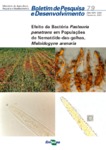Por favor, use este identificador para citar o enlazar este ítem:
http://www.infoteca.cnptia.embrapa.br/infoteca/handle/doc/551939| Título: | Efeito da bactéria Pasteuria penetrans em populações de nematóide-das-galhas, Meloidogyne arenaria. |
| Autor: | SHARMA, R. D.  MOREIRA, W. A.   ALVES, R. T.   |
| Año: | 2003 |
| Referencia: | Planaltina, DF: Embrapa Cerrados, 2003. |
| Páginas: | 12 p. |
| Descripción: | RESUMO: Objetivou-se com este trabaho avaliar a eficiência de Pasteuria penetrans em populações de Meloidogyne arenaria em casa-de-vegetação. Os tratamentos foram compostos de quatro doses de inóculo de P. penetrans: 0,3,25x(10 elevado a 5) , 6,50x(10 elevado a 5) e 1,300x(10 elevado a 6) endósporos/kg de solo/vaso aplicadas em solo naturalmente infestado com Meloidogyne arenaria e outros nematóides fitoparasitas. Logo depois da incorporação da bactéria foi semeada, uma semente de feijão (cv. Carioca) por tubo. O experimento foi avaliado em três etapas: a primeira, passados 77 dias do plantio do feijão; a segunda, aos 133 dias depois do primeiro plantio da soja cv. Cristalina e a terceira, 108 dias depois do segundo plantio da soja cv. Doko RC em sequência. Na primeira etapa, houve redução drástica na população final de M. arenaria em relação à população inicial em todos os tratamentos devido ao ataque severo do nematóide, resultando na morte das plantas. Na segunda etapa, houve ligeiro aumento na população final do nematóide M arenaria no tratamento 6,50x (10 elevado a 5) endósporos/kg de solo mas não houve diferença significativa entre os tratamentos. Na terceira etapa, o nematóide M. arenaria foi eliminado totalmente do solo em todos os tratamentos (p<0,05). A bactéri P. penetrans mostrou-se altamente eficiente no controle do M. arenaria, mesmo no nível mais baixo (3,25.10 5, endósporos/kg de solo), no período de 318 dias. ABSTRACT: In a greenhouse experiment, the efficiency of Pasteuria penetrans was evaluated against the populations of Meloidogyne arenaria using naturally infested soil with this nematode on three susceptible crops grown in a sequence (common bean-soybean-soybean), using four inoculum levels of P. penetrans viz., 0 (check); 3,25x10 5 e 1,300x10 6 endospores/kg of soil/tube. After incorporation of bacteria, one seed of common bean was sown per pot. The experiment was evaluated in three steps: 77 days after planting common bean (cv. Carioca); 133 days after planting soybean (cv.Cristalina) and 108 days second planting of soybean (cv. Doko RC). There was no difference between the treatments in the first evaluation (p>0,05). In the second evaluation, the little increase in the final population of M. arenaria was observed with 6,5x10 5 endospores/kg of soil, but did not differ significantly from other treatments. In the third evaluation, M. arenaria populations were eliminated in all the treatments and differed significantly (p<0.05) from the check. The results showed that P. penetrans is highly efficient in the control of M. arenaria, even at the lowest level (3,25x10 5 endospores/kg of soil) within a period of 318 days. |
| Thesagro: | Bactéria Controle Biológico Feijão Glycine Max Galha Nematóide Phaseolus Vulgaris Soja |
| NAL Thesaurus: | Pasteuria penetrans Nematoda biological control soybeans |
| Palabras clave: | Plant galls Bean |
| Citación: | (Embrapa Cerrados. Boletim de Pesquisa e Desenvolvimento, 79). |
| Tipo de Material: | Folhetos |
| Acceso: | openAccess |
| Aparece en las colecciones: | Boletim de Pesquisa e Desenvolvimento (CPAC)  |
Ficheros en este ítem:
| Fichero | Descripción | Tamaño | Formato | |
|---|---|---|---|---|
| bolpd79.pdf | 1,16 MB | Adobe PDF |  Visualizar/Abrir |









